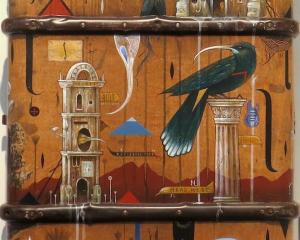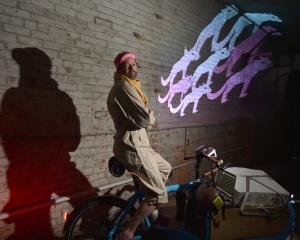In this week's Art Seen, James Dignan looks at works by Di ffrench, Brendan John Philip, and an exhibition from Otago Museum.
 And Through the Field the Road Runs By, by Di ffrench.
‘‘Enduring Legacy’’, Di ffrench (Fe29 Gallery)
And Through the Field the Road Runs By, by Di ffrench.
‘‘Enduring Legacy’’, Di ffrench (Fe29 Gallery)

The work of masterful Dunedin photographer Di ffrench is the subject of the retrospective exhibition ''Enduring Legacy'' at Fe29 Gallery. The artist, who died in 1999, left behind a body of powerful works. These include gentle monochrome portraits, mixed media studies of church frescoes, and - most notably - her forceful cibachrome constructions centred around the male and female nude.
These last works form the centrepiece of the exhibition. They owe a massive debt to medieval and renaissance art in both composition and mood. The nudes that form the basis of these works are often rendered as semi-abstract forms, with images such as ''Taking possession'' relying on the interplay of light and form for effect. In other works, such as ''Annunciation'', early art composition is directly referenced as a backdrop against which the nude is placed in a way that is simultaneously appropriate and jarring.
The skill of the photographer is at all times present, in the materials as much as in the images. Using metallic base, high gloss surface and harsh cibachrome processing, figures appear as if suffused with an inner glow. A hard golden light pours down like honey, capturing the figures against a solid all-enshrouding black that is both bright and hard.
 Kali Yuga Blues, by Brendan Jon Philip.
‘‘Kali Yuga Blues’’, Brendan Jon Philip (Mint Gallery)
Kali Yuga Blues, by Brendan Jon Philip.
‘‘Kali Yuga Blues’’, Brendan Jon Philip (Mint Gallery)

Brendan Jon Philip also places his painted protagonists against a harsh, shining black background, but his portrait subjects are devoid not only of clothes, but also of flesh.
Using that most human of symbols, the skull, Philip aims to examine the human condition by juxtaposition of the bones with symbols taken from popular culture and esoteric studies, and simply by itself, isolated from reality. The works make strong use of metallic paint, most notably gold, providing us with works that can trace their lineage back to 17th-century memento mori images.
The works are well-created and are powerfully symbolic, the skulls often only roughly sketched into place, allowing the viewer to read into the pieces whatever he or she will. At first, the paintings seem crude and morbid, but with time and repeated viewing they almost become uplifting, and their roughness gives more character to the skulls. They gain their own personalities.
Alongside the smaller skull works are a handful of larger, more elaborate pieces where the cranium is joined by ribcages and limbs. The esoteric symbolism of many of the works is enhanced by their titles, which take their cue from Tarot, Celtic myth, the Kabbalah and Sanskrit scripture.
 Swannjars and Cuppas, by Three Cups of Tea Ceramics.
‘‘Current’’ (Otago Museum)
Swannjars and Cuppas, by Three Cups of Tea Ceramics.
‘‘Current’’ (Otago Museum)

At the end of last year, nine local artists and crafts people were asked to make new works inspired by items from Otago Museum's textile collection. The resulting items are the basis of the intriguing exhibition ''Current''.
Each of the pieces is not only an interesting work in its own right, but also sheds new light on the historic item which inspired it.
Several of the artists have understandably responded, like for like, with costumes. There is fine work on display from Jessica Leigh, the Steep Street collective, and especially Melanie Child, though the scene is stolen in the fashion stakes by Max Mollison's outrageous crab suit, inspired by a mock-crustacean 1950s cocktail hat.
Painting and installation works add an extra dimension to the exhibition. James Bellaney's vibrant pictorial designs draw on African tribal costume as an inspiration. Flynn Morris-Clarke's subtle, flowing oil painting and Devon Smith's soft, delicate portraits effectively echo the high-fashion silks which inspired them.
The two installation works are the show's highlights, however. In one, a silk hood is rendered even more enigmatic by Kelly O'Shea's presentation of it within a protective viewing tent. In the other installation, Three Cups of Tea Ceramics (Karen Taylor O'Neill and Elise Johnston) humorously riff on the iconic Swanndri with their domestic kiwiana ceramics.












![... we all become all of these things [installation view] (2025), by Megan Brady.](https://www.odt.co.nz/sites/default/files/styles/odt_landscape_small_related_stories/public/story/2025/03/1_we_all_become_all_of_thes.jpg?itok=nicA_yAm)